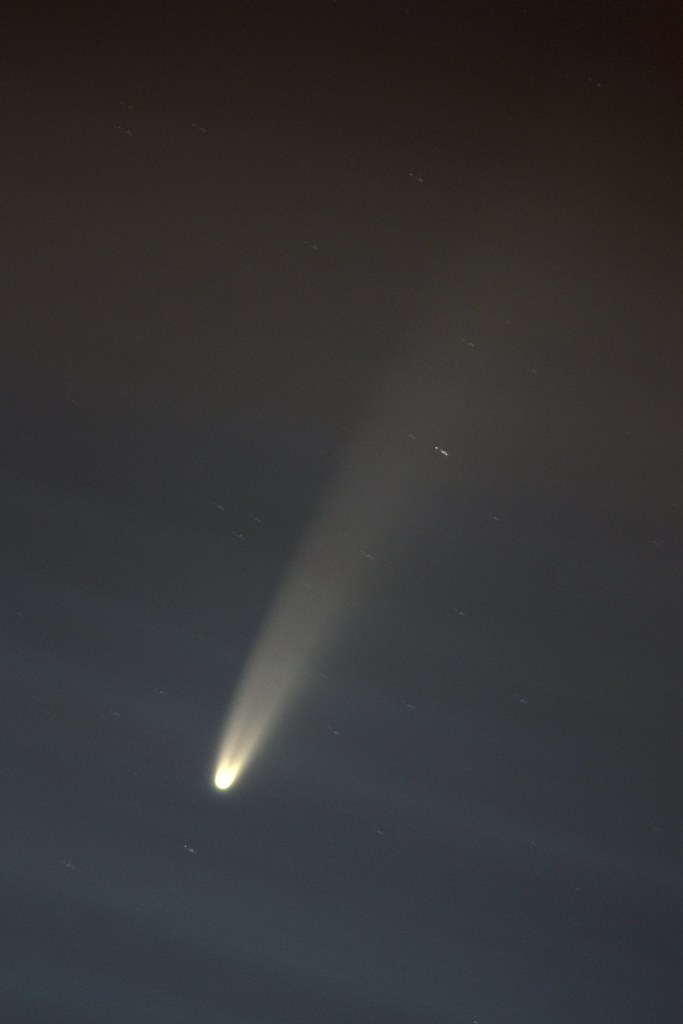Comet NEOWISE Part 1
For several days leading up to the second weekend of July the internet had been buzzing with the first thrilling naked eye observations of Comet C/2020 F3 (NEOWISE). The comet had been first sighted by the WISE space telescope, an earth orbiting satellite that had most recently been looking out for near-Earth objects (NEO), in late March. As the comet rounded the Sun on the 3rd July, the 5km wide icy ball rapidly brightened to around 2nd or 1st magnitude, making it naked eye from even a modest dark sky. People with clear skies were capturing some beautiful images of the comet in the dusky glow of twilight and it was getting better every day. After the disappointing fading of comets SWAN and ATLAS earlier in the year, NEOWISE was shaping up to be a sight to see, likely the best comet since the brief appearance of Comet McNaught in the northern hemisphere in early 2007, and before that, Hale-Bopp in 1997.
 Above: the light curve for Comet C/2020 F3 NEOWISE as determined by recorded observations. Data and graph from the Comet Observation Database.
Above: the light curve for Comet C/2020 F3 NEOWISE as determined by recorded observations. Data and graph from the Comet Observation Database.
11th July
To see NEOWISE for myself I ideally needed clear northern skies on a weekend night as I knew I wasn’t going to be getting to bed before 3am if all went well. My first chance to view the comet therefore came into the early hours of the 11th July with a forecast set for clear intervals. I set an alarm for 00:45 and Leslie and I bundled up and drove west and up to the top of the Sherrifmuir Road. This climbs onto the western shoulder of the Ochil Hills, north of Stirling and allows for a good northern view with very little light pollution in the direction of the Highlands. It was a cool, pleasant sort of summer's night with just a touch of a breeze.
Of course, at 56N it is still pretty light at this time of year but at the darkest point of the night, with just a bright band of light along the northern horizon, we stepped out to dark, reasonably clear skies and - most importantly - Comet NEOWISE very clearly visible! It was a beautiful sight, the bright nucleus of the comet easily seen with the fainter dust tail trailing out above and to the right. It was an almost unreal sight, this wanderer from the outer solar system standing out clear and bright against a backlit summer sky.
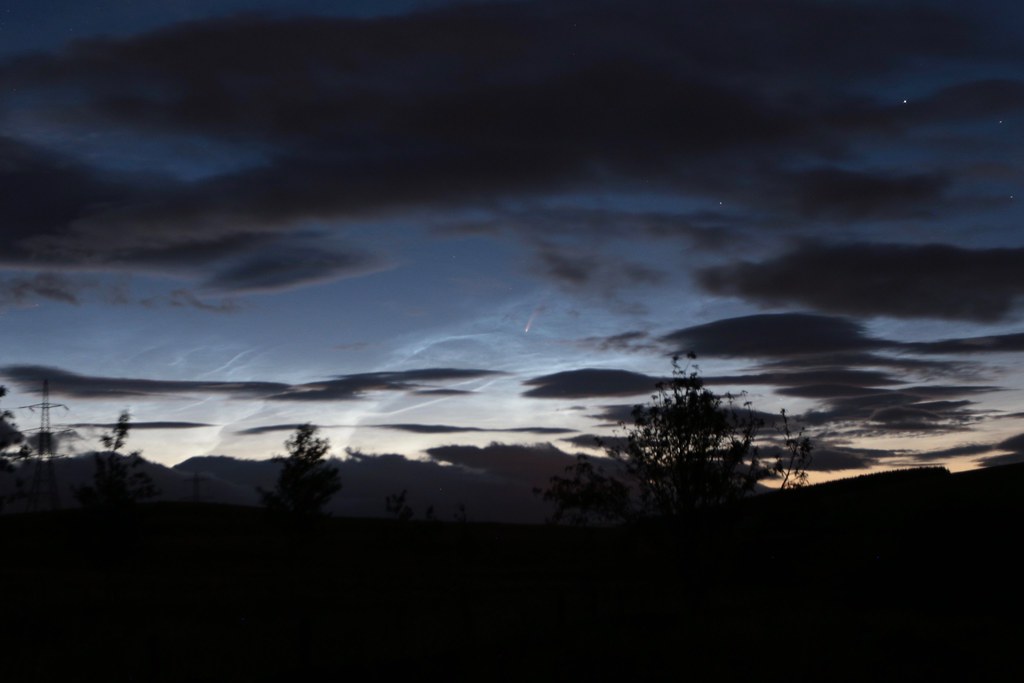 Above: my first image of NEOWISE taken at 01:46 on 11th July 2020. Canon 6D, 17-40mm lens at 40mm, f/4, 6s, ISO800
Above: my first image of NEOWISE taken at 01:46 on 11th July 2020. Canon 6D, 17-40mm lens at 40mm, f/4, 6s, ISO800
We spent a few minutes just gazing at it, before using binoculars and then finally getting the 80mm telescope trained on it. It was an utterly incredible sight. To the eye it appeared white but the telescope revealed a golden aura to the comet. The dust tail was clear, stretching wide across the field of view like a searchlight.
 Above: a view of Comet Neowise through the 30mm eyepiece on a Vixen ED80 telescope taken with my Pixel 2. Neowise is reversed due to the mirror diagonal.
Above: a view of Comet Neowise through the 30mm eyepiece on a Vixen ED80 telescope taken with my Pixel 2. Neowise is reversed due to the mirror diagonal.
Faint noctilucent clouds had already appeared in the sky by this point, their shimmering silvery tendrils extending out across the northern horizon. This was an exciting development (I hadn’t seen a good display for a few years) but it soon became clear that they were going to cause us to lose naked eye sight of the comet as the contrast of the sky rapidly decreased. Nevertheless the views of NEOWISE through the telescope remained and I eventually hooked up the camera to get a few detailed photos. The noctilucent clouds did wash out a lot of the details but made for very beautiful images, the comet seen through a rippling pattern of blues and greys.
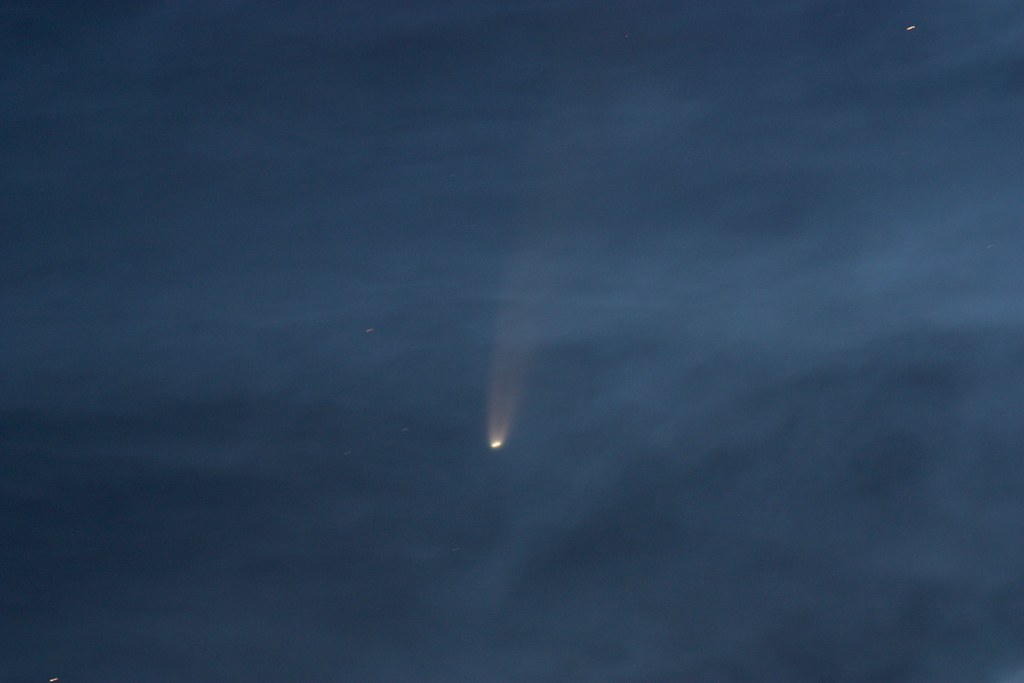 Above: Comet Neowise taken with a Canon 450D at prime focus on a Vixen ED80sf telescope. A single untracked 5s exposure at ISO200.
Above: Comet Neowise taken with a Canon 450D at prime focus on a Vixen ED80sf telescope. A single untracked 5s exposure at ISO200.
The NLCs themselves turned into a spectacular display which extended across the whole northern horizon and overhead with complex and intricate structures. They kept me out photographing much longer than I intended!
 Above: Noctilucent Clouds extending across the northern horizon at 03:17am. Canon 6D, 17-40mm lens at 17mm, f/6.7, 4s, ISO400.
Above: Noctilucent Clouds extending across the northern horizon at 03:17am. Canon 6D, 17-40mm lens at 17mm, f/6.7, 4s, ISO400.
To cap off the night I saw two orbits of the International Space Station, managing to capture one as it glided over the nearby hill of Dumyat. I didn't have much time to adjust my settings so was pleased to pick it up in a photo. In the south both Jupiter and Saturn shone brightly but drew little interest with NEOWISE in the sky.
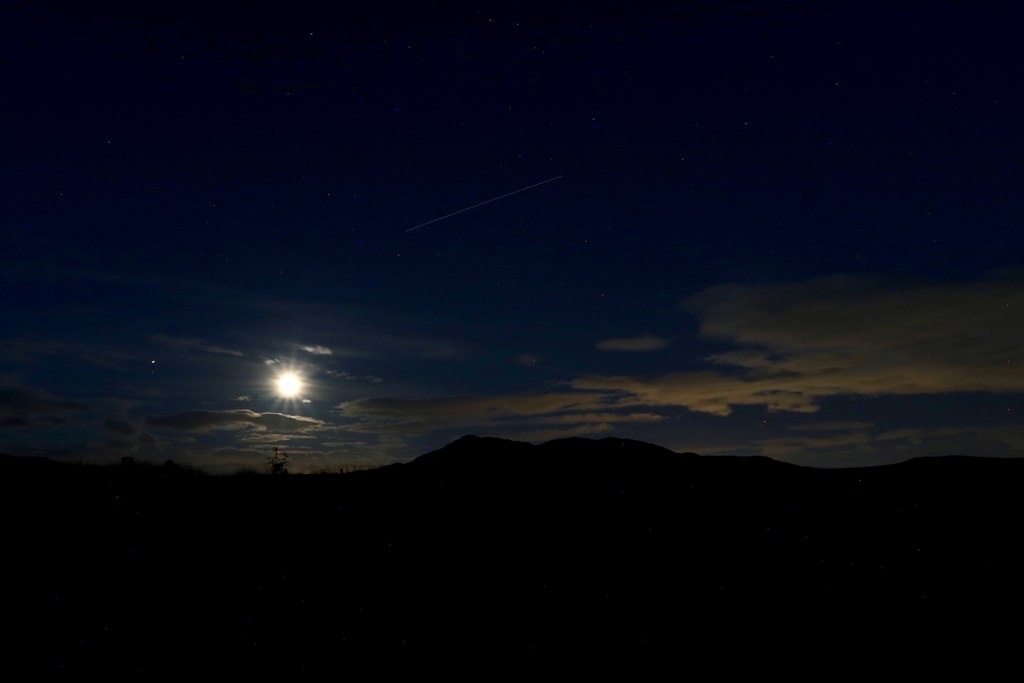 Above: the International Space Station passes over Dumyat at 01:54 on 11th July. Canon 6D, 17-40mm lens at 17mm, f/16, 30s, ISO800.
Above: the International Space Station passes over Dumyat at 01:54 on 11th July. Canon 6D, 17-40mm lens at 17mm, f/16, 30s, ISO800.
12th July
After success the previous night I was keen to get out again with another clear spell forecast overnight. This time I drove up to the hills south of Tillicoultry with the hope that I would be high enough to see NEOWISE over the Ochil Hills. Although the hillfoot villages throw up light pollution I was hoping the darkness of the Ochils themselves would provide at least decent viewing conditions.
Sadly, I pulled up to the parking area near Forestmill on the A977 to be greeted by thick clouds and a blustery wind. I sat in the car for an hour, getting out every 10 minutes to stamp my feet and see if a gap had appeared in the clouds. Although the odd slim gap did appear over the dark silhouette of the hills there was no sign of NEOWISE. Back in the car I had a quick look at the satellite images on my phone and decided to try my luck a little further west where it appeared that the cloud might be a little patchier. I drove around to Stirling and then along the road towards Doune where I parked up at the David Stirling memorial which has a commanding view over the Trossachs and, most importantly, a clear northern horizon.
I was greatly relieved on arrival at the dark parking area to see the clouds starting to break up and soon I had my first sight of NEOWISE. In contrast to the previous night the tail was more elongated and seemed narrower and brighter. Despite starting before midnight the cloudy conditions meant I took my first shot only a little earlier than the previous night. With promising skies I set up both the camera and the telescope including getting a rough polar alignment to allow for tracking.
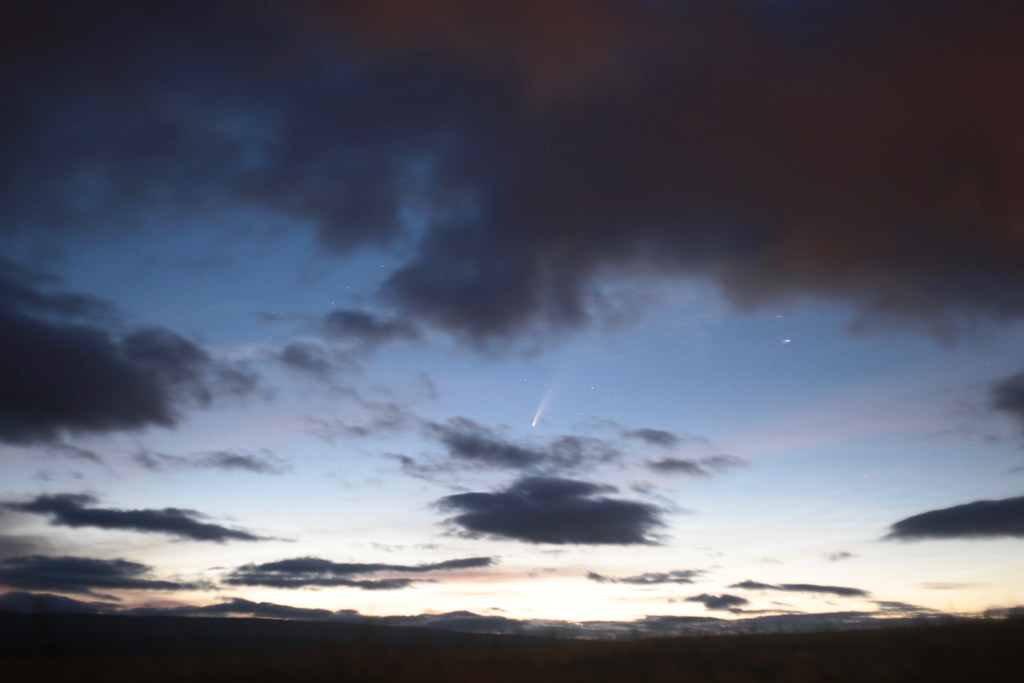 Above: Comet NEOWISE at 01:37BST, Canon 6D, 50mm lens, f/1.8. 3s, ISO1600
Above: Comet NEOWISE at 01:37BST, Canon 6D, 50mm lens, f/1.8. 3s, ISO1600
Clouds came and went but there were only faint noctilucent clouds so the views were generally better than the previous night. There appeared less colour in NEOWISE's tail but it definitely stretched out to a great extent. Sadly I’d missed the darkest part of the night whilst clouded out so the sky was brightening rapidly and NEOWISE getting fainter.
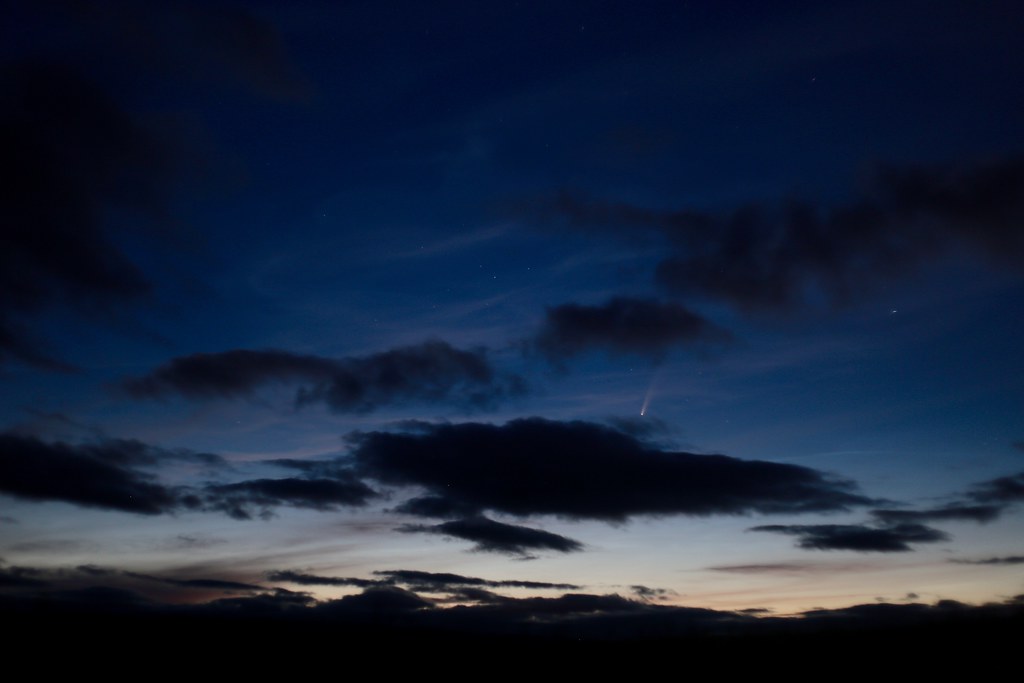 Above: Comet Neowise at 01:59BST. Canon 6D, 50mm lens, f/1.8, 1.5s, ISO400
Above: Comet Neowise at 01:59BST. Canon 6D, 50mm lens, f/1.8, 1.5s, ISO400
Again I captured a mixture of widefield and telescope photos of the comet before the approaching dawn washed out NEOWISE from the sky. During the night at times when the comet was hidden by cloud patches I also observed Jupiter, Saturn, Mars and the rising moon. It was a beautiful night with the air very still making visual observations of the planets a joy.
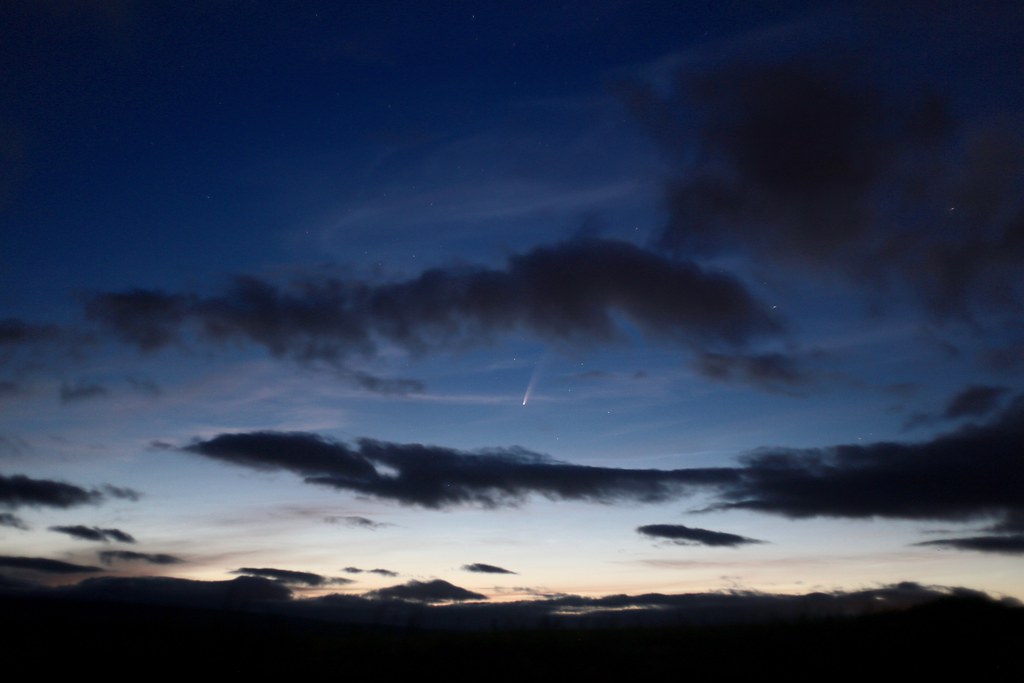 Above: Comet Neowise at 02:04BST. Canon 6D, 50mm lens, f/1.8, 1.5s, ISO400
Above: Comet Neowise at 02:04BST. Canon 6D, 50mm lens, f/1.8, 1.5s, ISO400
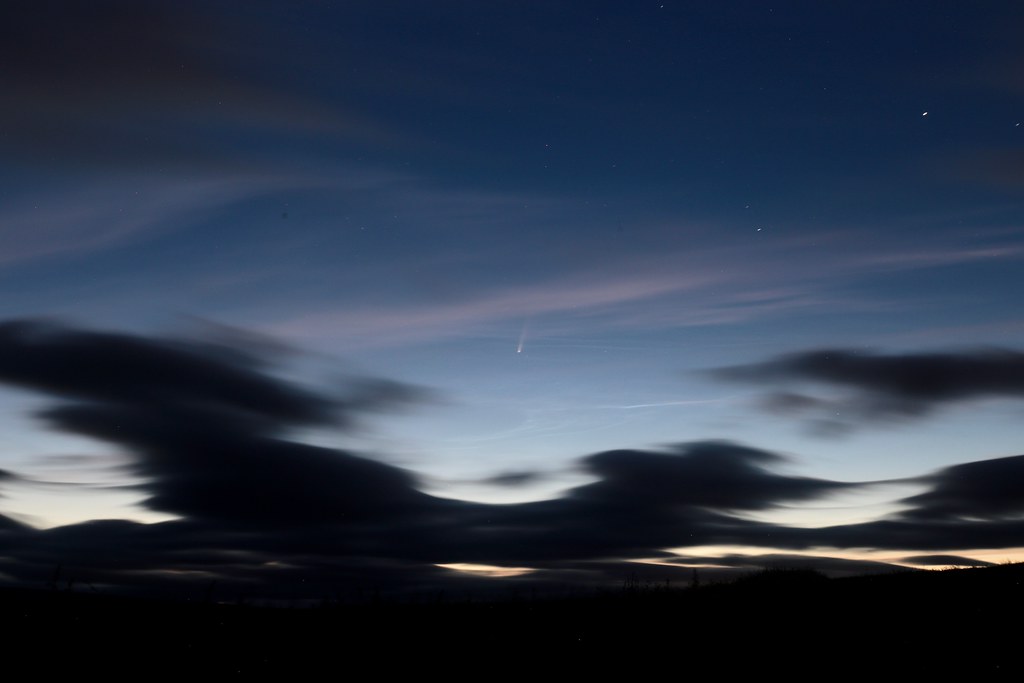 Above: Comet Neowise at 02:39BST. Canon 6D, 50mm lens, f/11, 30s, ISO400
Above: Comet Neowise at 02:39BST. Canon 6D, 50mm lens, f/11, 30s, ISO400
I was able to stack a number of my telescope images to create a nice portrait of NEOWISE against the subtly-clouded sky. My tracking wasn't perfect but the alignment done by the software resulted in a decent image with some detail seen in the dust tail. There was no hint of any ion tail despite my best efforts to stretch the image.
Above: Comet Neowise. Vixen ED80sf Telescope, Canon 450D, 10 x 5s exposures, aligned and stacked in Nebulosity and processed in Darktable
With dawn approaching I packed up and drove home, very happy to have got clear conditions after the somewhat disappointing start to the night.
